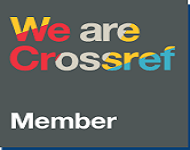Analisis Kemampuan Penalaran Siswa SMP dalam Memecahkan Masalah Matematika Berdasarkan Jenis Gaya Belajar
DOI:
https://doi.org/10.33394/jp.v9i3.5286Keywords:
Analysis, Reasoning Ability, Learning Style.Abstract
References
Andriani, D. N (2014). Kompetensi Profesional Guru, Motivasi, dan Gaya Belajar Berpengaruh Terhadap Pemahaman Ekonomi Siswa Kelas XI IPS di SMA Negeri 1 Gondang Nganjuk. Jurnal Ekonomi Pendidikan Dan Kewirausahaan, 2(1), 42-56.
Astuti, P., & Sariningsih, R. (2018). Analisis Kemampuan Penalaran Matematik Siswa Smp Pada Soal-Soal Materi Segi Empat Dan Segitiga. JPMI (Jurnal Pembelajaran Matematika Inovatif), 1(4), 807.
Chan, D. M., & Rahman, I. (2019). Pengaruh Gaya Belajar Terhadap Hasil Belajar Pada Mata Kuliah Keterampilan Mebaca Mahasiswa Prodi Pendidikan Bahasa dan Sastra Indonesia STKIP YDB Lubuk Alung. KEMBARA : Jurnal Keilmuan Bahasa, 5(1), 27–39.
Erawati, N. K., & Purwati, N. K. R. (2020). Kemampuan Pembuktian Matematika Berdasarkan Gender Dan Gaya Belajar. Prima: Jurnal Pendidikan Matematika, 4(2),
Hermawan, A. S., & Hidayat, W. (2018). Meningkatkan Kemampuan Penalaran Matematik Siswa Smp Melalui Pendekatan Penemuan Terbimbing. JPMI (Jurnal Pembelajaran Matematika Inovatif), 1(1), 7.
Hermawan, F., & Winarti, E. . (2015). Komparasi Kemampuan Penalaran Matematis Peserta Didik Antara Pembelajaran Savi Dan Vak Dengan Pendekatan Saintifik. Unnes Journal of Mathematics Education., 4(1).
Hidayat, W. (2017). Adversity Quotient Dan Penalaran Kreatif Matematis Siswa Sma Dalam Pembelajaran Argument Driven Inquiry Pada Materi Turunan Fungsi. KALAMATIKA Jurnal Pendidikan Matematika, 2(1), 15.
Hidayat, W., Wahyudin, & Prabawanto, S. (2018). Improving students’ creative mathematical reasoning ability students through adversity quotient and argument driven inquiry learning. Journal of Physics: Conference Series, 948(1).
Keliat, N. R. (2016). the Profile of Students’ Learning Styles and Their Effects on Grade Point Average (Gpa) Achievement. Edutech, 15(2), 188.
Liberna, H. (2018). Hubungan Gaya Belajar Visual dan Kecemasan Diri Terhadap Pemahaman Konsep Matematika Siswa Kelas X SMK Negeri 41 Jakarta. JNPM (Jurnal Nasional Pendidikan Matematika),
Nurmanita, & Surya, E. (2017). Membangun Kemampuan Penalaran Matematis (Reasoning Mathematics Ability) Dalam Pembelajaran Matematika. December.
Prabasari, B., & Subowo. (2017). Pengaruh Pola Asuh Orang Tua Dan Gaya Belajar Terhadap Prestasi Belajar Melalui Motivasi Belajar Sebagai Variabel Intervening. Economic Education Analysis Journal P-ISSN 2252-6544 e-ISSN 2502-356X, 6(2), 549–558.
Puspita, M. D., Prayito, M., & Sugiyanti, S. (2020). Analisis Kemampuan Penalaran Siswa SMA dalam Memecahkan Masalah Matematika Ditinjau dari Gaya Belajar Visual. Imajiner: Jurnal Matematika Dan Pendidikan Matematika, 2(2), 141–150. 6
Ramadani, R., Mustamin, S. H., & Idris, R. (2017). Hubungan Antara Kreativitas Guru Dan Gaya Belajar Siswa Dengan Hasil Belajar Matematika Siswa Kelas X Sma Negeri 1 Bontomarannu Kabupaten Gowa. MaPan, 5(1), 82–95.
Riyanti, F., & Rustiana, A. (2019). Pengaruh Gaya Belajar, Kesiapan Belajar Melalui Motivasi Belajar Sebagai Variabel Intervening Terhadap Keaktifan Belajar. Economic Education Analysis Journal, 7(3), 1083–1099.
Rosmaiyadi, R. (2017). Analisis Kemampuan Berpikir Kritis Matematis Siswa Dalam Learning Cycle 7E Berdasarkan Gaya Belajar. AKSIOMA: Jurnal Program Studi Pendidikan Matematika, 6(1), 12.
Sariningsih, R. (2014). Pendekatan Kontekstual Untuk Meningkatkan Kemampuan Pemahaman Matematis Siswa Smp. Infinity Journal, 3(2), 150.
Shidiq, U., & Choiri, M. (2019). Metode Penelitian Kualitatif di Bidang Pendidikan. In Journal of Chemical Information and Modeling (Vol. 53, Issue 9).
Sugiyono. (2012). Memahami Penelitian Kualitatif. Bandung: ALFABETA.
Yusdiana, B. I., & Hidayat, W. (2018). Analisis Kemampuan Penalaran Matematis Siswa Sma Pada Materi Limit Fungsi. JPMI (Jurnal Pembelajaran Matematika Inovatif), 1(3),
Downloads
Published
How to Cite
Issue
Section
Citation Check
License
License and Publishing Agreement
In submitting the manuscript to the journal, the authors certify that:
- They are authorized by their co-authors to enter into these arrangements.
- The work described has not been formally published before, except in the form of an abstract or as part of a published lecture, review, thesis, or overlay journal.
- That it is not under consideration for publication elsewhere,
- That its publication has been approved by all the author(s) and by the responsible authorities tacitly or explicitly of the institutes where the work has been carried out.
- They secure the right to reproduce any material that has already been published or copyrighted elsewhere.
- They agree to the following license and publishing agreement.
Copyright
Authors who publish with Jurnal Paedagogy agree to the following terms:
- Authors retain copyright and grant the journal right of first publication with the work simultaneously licensed under a Creative Commons Attribution License (CC BY-SA 4.0) that allows others to share the work with an acknowledgment of the work's authorship and initial publication in this journal.
- Authors are able to enter into separate, additional contractual arrangements for the non-exclusive distribution of the journal's published version of the work (e.g., post it to an institutional repository or publish it in a book), with an acknowledgment of its initial publication in this journal.
- Authors are permitted and encouraged to post their work online (e.g., in institutional repositories or on their website) prior to and during the submission process, as it can lead to productive exchanges, as well as earlier and greater citation of published work.
Licensing for Data Publication
-
Open Data Commons Attribution License, http://www.opendatacommons.org/licenses/by/1.0/ (default)






